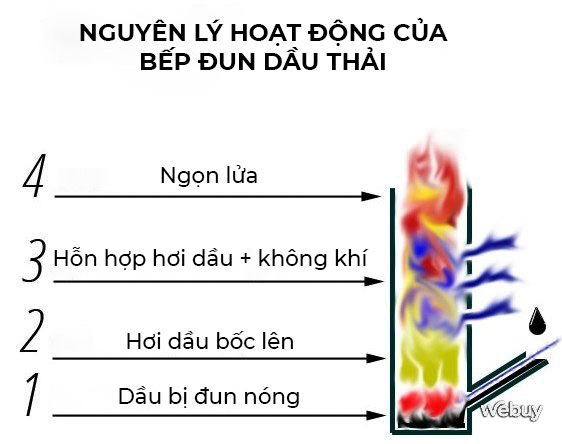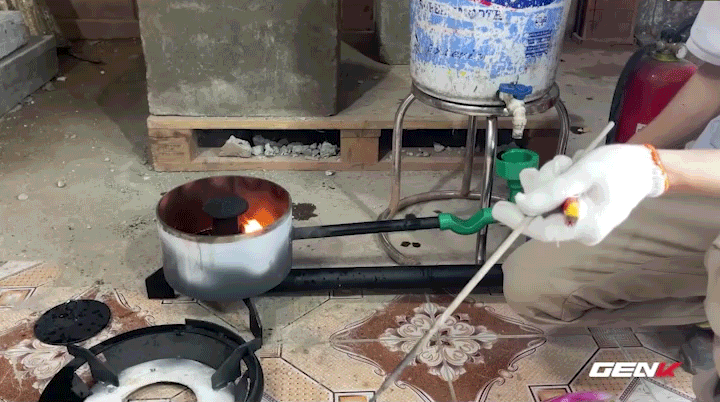Recently on the market appeared a type of stove introduced as “research work of Japanese engineers and developed in Vietnam” (verbally – Japan) to help “save 10 times more”. times” compared to gas and electric heating.

Although this product has many models, they are advertised with strong points that make any consumer feel really interested: low cost, high efficiency, safe, non-toxic… In general, everything we “need and want” in a kitchen, this type of kitchen can meet. Is there really such a “delicious-healthy-cheap” product that costs only a few hundred thousand dong?

Structure of the waste oil stove

These rudimentary waste oil stoves probably have nothing to do with the word “Japan”.
Currently, most waste oil stoves in Vietnam are handmade and each manufacturer has a little variation. Depending on the production facility, the stove is made from soldering iron or stamped whole plate, but in general, these types of stoves all share some main parts, including:
1. Kitchen body;

2. Oil tank and pipeline;
3. Forced air blower and air duct;
4. Air column with drill hole (dead welding or removable);

5. Kitchen brackets (also kitchen lid);

Working principle
Waste oil stoves have the same operation as the “old” kerosene stoves in the 90s and earlier in the countryside. At that time, people used kerosene as fuel to run stoves. The user needs to light a fire (with paper or a matchstick) to burn the ends of the wicks. Oil will soak up the body of the wick (capillary phenomenon) and ignite.

Later, to save fuel, people devised a plan to burn waste oil. This oil can be applied for free or bought cheaply at many mechanical or motorcycle repair shops, car garages…
Using
Another difference of a waste oil stove compared to a kerosene stove is that it does not use a wick, but rather burns “flammable hydrocarbons that are gasified”, so the first operation when using a waste oil stove is to “ignite the fire”.

Starting the fire for the waste oil stove is the most important operation
Before starting the stove, users need to pour a small amount of oil into the heart of the stove and then burn a few sheets of paper to bring the temperature on the oil surface to a threshold enough to make the flammable hydrocarbon components turn into vapor, then slowly let it air. “fresh” gas (actually oxygen) is introduced to form a gas-rich combustion mixture and sustain the flame.
This first step is very important because if the fan is too loud, it will extinguish the ignition, and if the fan is not strong enough, there is not enough oxygen to maintain the fire.

When the fire has burned evenly and stably, put the stove on and can be used. Depending on the type of stove, fuel and proficiency of the user, this “kitchen group” process can last from 3-5 minutes.
During the cooking process, the fan must continuously operate to provide air, and the user must also pay attention to oil loading to maintain a certain amount of oil in the body of the stove.
Because the kitchen uses a forced-air blower (capacity from 20 to 100W depending on the manufacturer), the fire is very strong. Therefore, to ensure fire safety, users also need to have fire prevention and fighting means and equipment located around.

To use the waste oil stove, it is indispensable… a fire extinguisher
According to the advertisement, the input fuel for this kitchen is very diverse, from motorcycle oil to restaurant waste frying fat or even roast pork fat, roast duck can be used for burning.
Manipulating the kitchen group took time, but stopping the kitchen also needed a little patience. Unlike kerosene stoves (twist the wick to turn off the fire) or gas stoves (turn the knob to turn off gas), the gasification process occurs directly on the oil surface in the body of the stove, so the user must disconnect the oil supply line and let the gas flow. Burn all the oil in the stove. If you deliberately turn off the stove forcibly, the smoke and oil vapor in the kitchen will rise a lot, posing a danger to health and fire safety.
Advertising Waste Oil Stove – Super Saving Waste Oil Stove on Facebook
Preliminary comments
For a long time in the world, there have been many researches on burning waste oil as well as equipment using waste oil as fuel to save costs and reduce harm to the environment caused by the treatment of waste oil. properly… However, these types of furnaces are mainly used for heating factories, burning garbage, metallurgy… but few people use them for cooking in the family. And despite being advertised as smokeless and non-toxic, consumers should note the following points:
1. About the origin:
All types of waste oil stoves sold in Vietnam are of “domestic” origin, and we have not found any information related to Japanese technology as advertised.

2. About health safety:
– Starting the initial fire and putting out the fire after cooking, both produce black smoke and smell because the temperature in the kitchen is not high enough to ignite the oil vapors.

Black smoke is born when the kitchen group
– The input fuel composition is not uniform due to collection from many sources, industrial waste oils contain many toxic impurities.
– The wind pressure caused by the slug fan of several tens of W is not enough to disperse the oil droplets, so the burning takes place incompletely and the oil vapor will stick to the pot as well as the food when cooking. No one knows what impact the use of this waste oil stove will have on human health in the long run.
– There has not been any certificate or analysis of the exhaust gas composition of the stove to confirm that this stove is “non-toxic”. If only based on “no smoke, no smell” and concluded that it is not toxic, it is dangerous, because CO gas (born when burning honeycomb charcoal) is also odorless but its consequences for With human health and life, everyone understands.
3. Regarding fire safety:
– The stove uses liquid fuel and produces petrochemicals, but the structure of the stove does not have any safety mechanism to prevent fire or explosion or fuel leakage. Therefore, the use of waste oil stoves has many potential risks of unsafe fire prevention and fighting.
In the following article, we will compare the difference between cooking a gas stove and a waste oil stove with a difference of up to 10 times as advertised!
